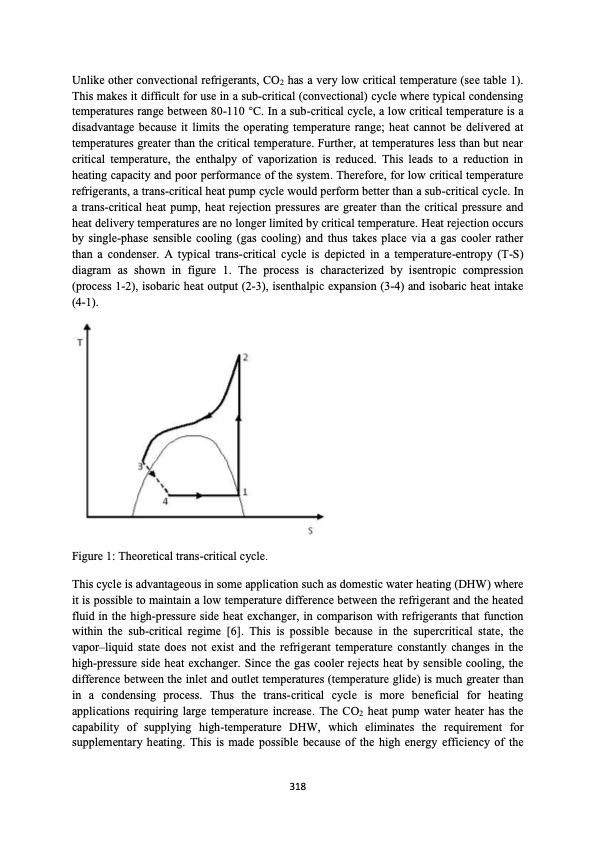
PDF Publication Title:
Text from PDF Page: 003
Unlike other convectional refrigerants, CO2 has a very low critical temperature (see table 1). This makes it difficult for use in a sub-critical (convectional) cycle where typical condensing temperatures range between 80-110 °C. In a sub-critical cycle, a low critical temperature is a disadvantage because it limits the operating temperature range; heat cannot be delivered at temperatures greater than the critical temperature. Further, at temperatures less than but near critical temperature, the enthalpy of vaporization is reduced. This leads to a reduction in heating capacity and poor performance of the system. Therefore, for low critical temperature refrigerants, a trans-critical heat pump cycle would perform better than a sub-critical cycle. In a trans-critical heat pump, heat rejection pressures are greater than the critical pressure and heat delivery temperatures are no longer limited by critical temperature. Heat rejection occurs by single-phase sensible cooling (gas cooling) and thus takes place via a gas cooler rather than a condenser. A typical trans-critical cycle is depicted in a temperature-entropy (T-S) diagram as shown in figure 1. The process is characterized by isentropic compression (process 1-2), isobaric heat output (2-3), isenthalpic expansion (3-4) and isobaric heat intake (4-1). Figure 1: Theoretical trans-critical cycle. This cycle is advantageous in some application such as domestic water heating (DHW) where it is possible to maintain a low temperature difference between the refrigerant and the heated fluid in the high-pressure side heat exchanger, in comparison with refrigerants that function within the sub-critical regime [6]. This is possible because in the supercritical state, the vapor–liquid state does not exist and the refrigerant temperature constantly changes in the high-pressure side heat exchanger. Since the gas cooler rejects heat by sensible cooling, the difference between the inlet and outlet temperatures (temperature glide) is much greater than in a condensing process. Thus the trans-critical cycle is more beneficial for heating applications requiring large temperature increase. The CO2 heat pump water heater has the capability of supplying high-temperature DHW, which eliminates the requirement for supplementary heating. This is made possible because of the high energy efficiency of the 318PDF Image | TYPICAL INITIAL OUTPUT OF A CO2 HEAT PUMP

PDF Search Title:
TYPICAL INITIAL OUTPUT OF A CO2 HEAT PUMPOriginal File Name Searched:
paper_extended_length_energy_paper.pdfDIY PDF Search: Google It | Yahoo | Bing
CO2 Organic Rankine Cycle Experimenter Platform The supercritical CO2 phase change system is both a heat pump and organic rankine cycle which can be used for those purposes and as a supercritical extractor for advanced subcritical and supercritical extraction technology. Uses include producing nanoparticles, precious metal CO2 extraction, lithium battery recycling, and other applications... More Info
Heat Pumps CO2 ORC Heat Pump System Platform More Info
| CONTACT TEL: 608-238-6001 Email: greg@infinityturbine.com | RSS | AMP |